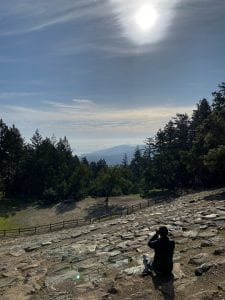Locations: Ridgecrest Blvd, Mill Valley US-CA (37.9144,-122.6093) (628 m)
Site Description: We visited the Mount Tamalpais area and made one main stop, where we walked along the trails to different parts of the forested area. We started off near the outdoor amphitheater and made our way around the park area, which was at lots of different elevations and there were many trails. Some spots were widely open, where there were just grasslands and spots of acidic soil where we saw little plant growth. Other spots were widely covered coniferous trees. It was a forested area with a few birds present, but a couple new species for the class to see. Most of the birds were hard to see as they were not seen flying in the open air that often. Most were covered within all the shrubs and trees so we could hear more than we could see.The area was far from any main highways so it was overall very quiet and scenic. The key bird species that were seen included: Band-tailed Pigeons, Acorn Woodpeckers, Northern Flickers, (Red-shafted), California Scrub-Jays, Common Ravens, Chestnut-backed Chickadees, Ruby-crowned Kinglets, and Dark-eyed Juncos (Oregon).
Species Account: Acorn Woodpeckers were the key new species seen on this trip and the ones seen most often in the area. These birds were seen mostly in the tall trees and they were seen in large quantities during our time on the trip. They flew back and forth from trees and tended to land on the base of the very tree high up — hanging on sideways. The trees that they built their acorn holes in were explained to be “dead trees” by Professor Paul. Professor Paul also pointed out that they flock together in groups and even work together to store their food. They had a very distinctive call that sounded almost like a squeak toy. It was repetitive and came as a burst of 3-4 “squeaks” every time we heard it. These birds were also very distinction in their color pattern when they flew overhead — flashing the white areas under their wings. Acorn Woodpeckers are medium-sized woodpeckers that are known to live in oak and evergreen forests along the Southwest and West Coast at higher altitudes (All About Birds). Acorn Woodpeckers have the key identifying feature of a bright red cap on their head. They are mostly black with a creamy white face. When they fly over head, you can see black and white coloration on their wings as well (All About Birds). Acorn Woodpeckers tend to live in groups and forage together by storing acorns the acorns they collect in holes made in trees or other wooden structures. (Audubon). They are known to be omnivorous and eat acorns and insects (Audubon).
Narrative: The class drove to Mount Tamalpais for this field trip. We left around 8 am on Thursday morning. It was a sunnier than average day in San Francisco, but still had a slight breeze. It continued to warm up as we got to Marin so it was a nice clear day to see birds. We hiked around the area around the amphitheater where we originally parked but did not see a large quantity of birds overall. It was a rather quiet day. But we did get to see a couple new and unique species to see that we had not seen before. There were not a lot of birds in the air either. We did see a couple Flickers in the air for a few moment— as they were quick in the air. These flickers were yellow colored and had soaring flight. There were not many Turkey Vultures or other soaring birds. Additionally, there were not any bodies of water in the area where we hiked, but we did make a stop at a beautiful viewpoint on the way back where we could see the water and a large portion of the peninsula. There were also many varieties of trees seen on this trip as well— ranging from rough bark to very smooth barked trees. It was also interesting to see how the acorn woodpeckers made holes in the dead trees in the area. Professor Paul explained the significance of keeping dead trees in the forest as well, as it is important for the ecosystem. We also learned that Acorn Woodpeckers tend to forage and store acorns together. I enjoyed this field trip for the unique new Acorn Woodpeckers seen and being able to hear a couple new bird songs that I had not heard before—especially the Acorn Woodpecker.
Additional Photos or Media: https://ebird.org/checklist/S64792716



